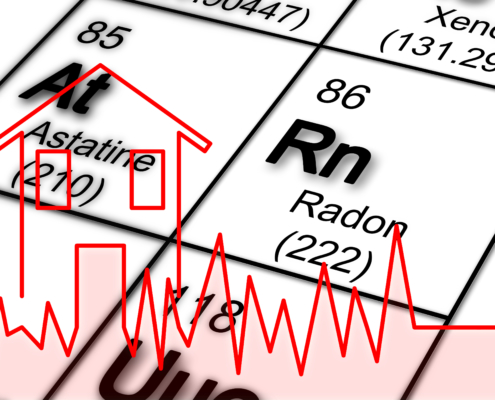What Is Radon Testing?
Radon testing is essential because radon is a radioactive gas that forms naturally when uranium breaks down in soil, rock, and water. It is invisible, odorless, and tasteless, making it difficult to detect without proper testing. Since radon is a gas, it can move through the soil and enter homes, accumulating to dangerous levels if not properly mitigated.
Where Does Radon Come From?
This gas is released from the natural decay of uranium found in soil, rock, and water. It rises through the ground and enters homes through cracks in foundations, walls, and floors. Homes with basements or crawl spaces are particularly vulnerable, but even those built on slabs can be affected. Radon can also enter through well water, releasing gas when the water is used for bathing, cooking, or drinking.
Why Is Radon Dangerous?
Exposure to radon presents serious radon exposure risks because it is the second leading cause of lung cancer, following smoking. Long-term exposure significantly increases the risk, particularly for smokers. The radioactive particles inhaled from radon decay damage lung tissue over time, leading to an increased chance of developing cancer. Because radon has no smell or taste, many homeowners are unknowingly exposed for years before discovering high levels in their homes.
How Does Radon Enter Homes?
Radon seeps into homes through multiple entry points. The most common ways are cracks in foundations, basement floors, and walls. It can also enter through openings around pipes, sump pumps, and drains. Homes with crawl spaces are at higher risk because radon can easily move through the soil and enter through gaps in flooring. Poor ventilation can negatively impact home air quality and cause radon to accumulate indoors, creating higher concentrations. Well water may also introduce radon into a home’s air during daily activities like showering or washing dishes.
Do Radon Levels Change Over Time?
Radon levels fluctuate throughout the year. During the winter, homes are sealed tightly to conserve heat, which can trap radon inside and lead to higher concentrations. In summer, increased ventilation and open windows may help lower radon assessment. Heavy rains and changes in barometric pressure can also influence radon concentrations, as shifting soil conditions affect how much radon escapes into the air. Because of these fluctuations, testing at different times of the year provides a more accurate assessment of radon detection in a home.
Can Renovations Affect Radon Levels?
Renovations can impact radon levels by altering the way air flows within a home. Major structural changes, such as finishing a basement, adding new rooms, or installing energy-efficient windows and doors, can trap radon inside. Sealing a basement can reduce natural ventilation, increasing radon accumulation. If any significant changes have been made to a home’s structure, it is recommended to retest for radon to ensure levels have not risen.
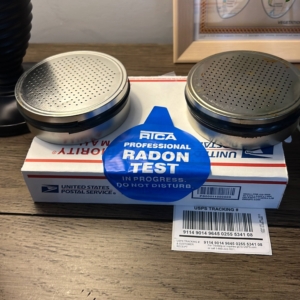 Radon Testing Methods
Radon Testing Methods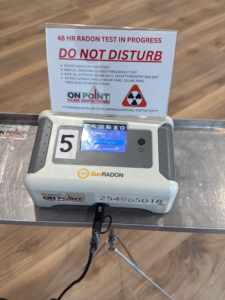
There are two main ways to test for radon: passive and active testing. Charcoal canisters are a passive test method that absorbs radon over a set period, typically two to seven days. Once the test is complete, the canister is sent to a laboratory for analysis. While this method is affordable and simple, it does not provide real-time results or long-term monitoring. Continuous Radon Monitors (CRM) are active devices that provide real-time radon readings. These monitors are typically used by professionals and offer greater accuracy and consistency in measuring radon levels over time. CRMs detect fluctuations, allowing homeowners to see patterns in radon concentration.
What Are Safe and Dangerous Radon Levels?
Radon is measured in picocuries per liter (pCi/L). The Environmental Protection Agency (EPA) considers radon levels of 4.0 pCi/L or higher to be dangerous and recommends mitigation. However, even levels between 2.0 and 4.0 pCi/L pose a health risk, and some homeowners opt to reduce radon at lower levels for additional safety. There is no completely safe level of radon, as exposure to any amount carries some risk. The EPA suggests taking action at levels of 4.0 pCi/L or higher, while the World Health Organization (WHO) recommends mitigation for levels exceeding 2.7 pCi/L. Many homeowners choose to install a mitigation system even at lower levels as part of their lung cancer prevention strategy.
How Do Radon Mitigation Systems Work?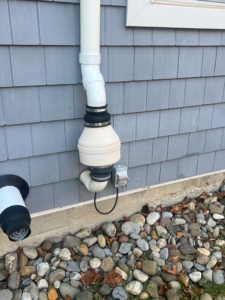
Radon mitigation systems prevent radon from accumulating inside the home by venting it outdoors. The most common type is a sub-slab depressurization system, which involves drilling a hole in the foundation and installing a pipe to draw radon from beneath the home. A fan is then installed to continuously pull radon gas from the soil and vent it outside, where it dissipates harmlessly. Other radon reduction methods include drain tile suction, which uses existing drainage systems to collect and redirect radon gas, and crawl space ventilation, which increases airflow to reduce radon concentration.
How Is a Radon Mitigation System Installed?
A professional radon removal installer begins by assessing the home’s structure and foundation. A suction point is created by drilling into the slab or basement floor. A PVC pipe is inserted and connected to a venting system that runs either through the home’s exterior wall or up through the attic. A fan is installed to maintain constant airflow, drawing radon from beneath the foundation and expelling it outside. The installer may also seal cracks and openings in the foundation to improve the system’s efficiency. After installation, a follow-up radon test ensures that levels have been successfully reduced. Watch a video on installing a radon mitigaton system here.
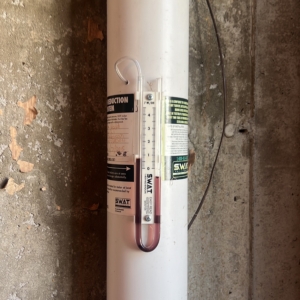 Radon Testing Frequency
Radon Testing Frequency
Homeowners should test for radon every two years, as levels can change over time due to environmental factors and structural modifications. If a home has undergone renovations or a mitigation system has been installed, retesting is recommended to confirm its effectiveness. Buyers and sellers should also test for radon during real estate transactions to ensure the home is safe.
Do You Need to Test If You Have a Mitigation System?
Even if a radon mitigation system is in place, periodic testing is necessary to confirm that it is functioning effectively. Fans and other system components can wear out over time, leading to increased radon levels. Testing every two years ensures that a home remains safe from radon exposure.
On Point Home Inspections is a Certified Indoor Air Quality Consultant based in Wilton, Connecticut. We offer radon measurement services in Wilton, Norwalk, Stamford, Darien, New Canaan, and throughout Fairfield County, as well as across Connecticut and New York. Call On Point Home Inspections to schedule a radon test today!

